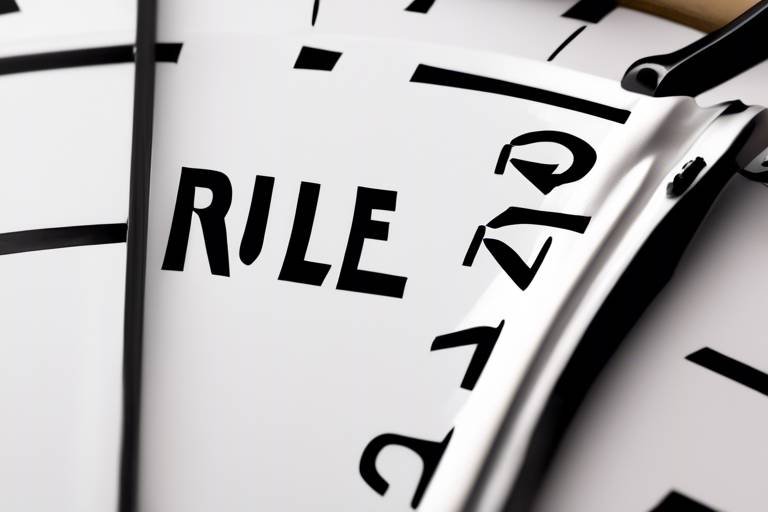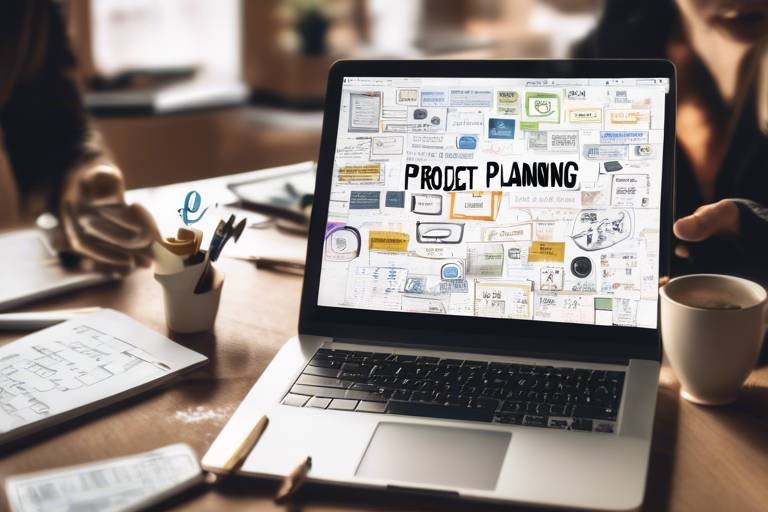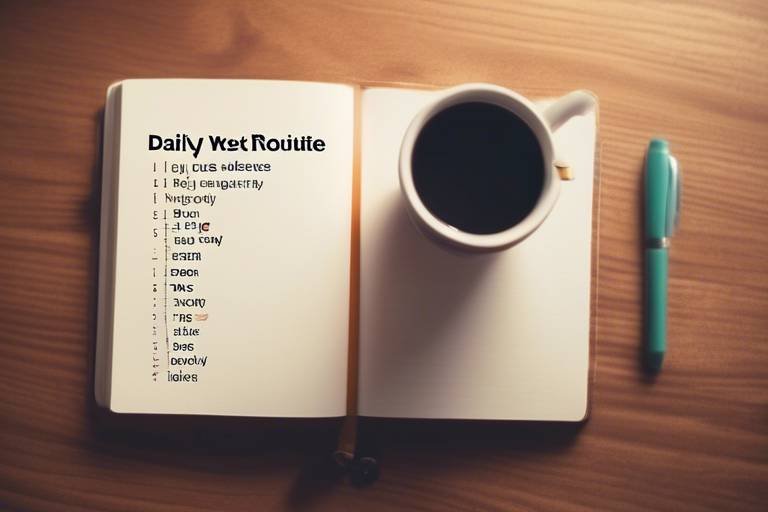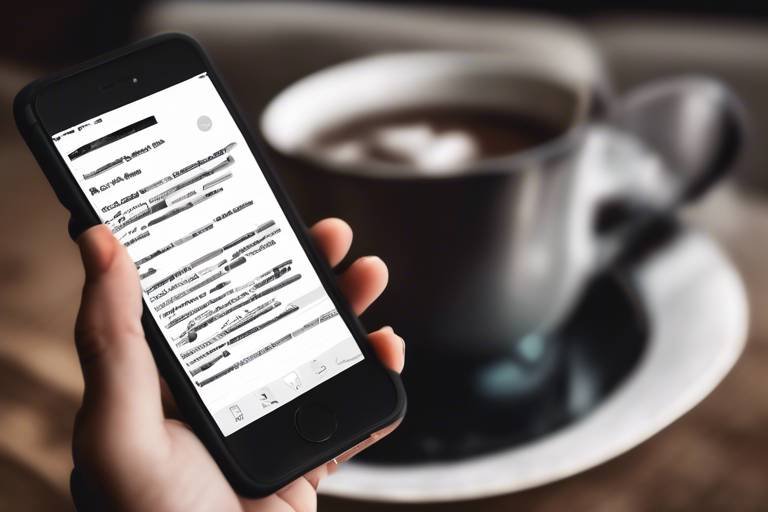How to Implement the Two-Minute Rule to Improve Efficiency
Efficient time management is the cornerstone of productivity. The Two-Minute Rule is a simple yet powerful concept that suggests tackling tasks immediately if they require two minutes or less to complete. By implementing this rule effectively, you can significantly enhance your efficiency in daily activities.

Understanding the Two-Minute Rule
The Two-Minute Rule is a simple yet powerful concept that can revolutionize the way you approach tasks in your daily life. Originating from productivity expert David Allen's "Getting Things Done" methodology, this rule suggests that any task requiring two minutes or less should be completed immediately. By understanding and implementing this rule, you can significantly enhance your efficiency and productivity.
Imagine your to-do list filled with small, quick tasks that often get pushed aside in favor of larger projects. The Two-Minute Rule encourages you to address these tasks promptly, preventing them from accumulating and creating mental clutter. By taking immediate action on these short tasks, you not only clear your plate but also free up mental space to focus on more significant endeavors.
When you grasp the essence of the Two-Minute Rule, you realize that it's not just about the time it takes to complete a task but the impact of swift action on your overall productivity. By promptly responding to emails, tidying up your workspace, or making minor decisions, you create a sense of accomplishment that propels you forward. This rule is not merely about time management; it's about maintaining momentum and workflow efficiency.

Identifying Two-Minute Tasks
The Two-Minute Rule is a powerful strategy that can significantly improve your efficiency and productivity by tackling quick tasks promptly. Identifying tasks that can be completed in two minutes or less is essential for effectively implementing this rule into your daily routine. These tasks are often small yet impactful, contributing to a sense of accomplishment and reducing mental clutter.
When identifying Two-Minute Tasks, consider activities that require minimal time and effort but can have a positive impact on your workflow. Examples of such tasks include responding to short emails, organizing your workspace, filing documents, or making brief phone calls. By recognizing these quick tasks, you can prioritize them for immediate action, preventing them from piling up and becoming overwhelming.
One effective way to identify Two-Minute Tasks is to create a list of potential activities that fall within the time frame. This list can serve as a reference point when deciding which tasks to address first and can help you stay focused on completing quick wins throughout your day. Additionally, categorizing tasks based on their estimated time requirements can further streamline your workflow and enhance your efficiency.

Benefits of Immediate Action
Efficient time management is crucial in productivity. The Two-Minute Rule suggests tackling tasks immediately if they take two minutes or less. Learn how to apply this rule effectively to boost efficiency in your daily routine.
Explaining the concept and origin of the Two-Minute Rule, which emphasizes completing quick tasks promptly rather than procrastinating. It aims to reduce mental clutter and increase productivity by addressing small tasks immediately.
Guidance on recognizing tasks that can be accomplished in two minutes or less, such as responding to emails, organizing files, or making quick decisions. Identifying these tasks is essential for efficient time management using the rule.
When you take immediate action on short tasks, you experience a range of benefits that contribute to increased productivity and reduced stress. The sense of accomplishment from quickly completing tasks can boost motivation and maintain workflow momentum. Moreover, addressing small tasks promptly allows you to free up mental space for more significant projects, preventing them from piling up and becoming overwhelming. By consistently applying the Two-Minute Rule and embracing immediate action, you can enjoy a more organized and efficient work routine.
Providing strategies and tips for effectively implementing the Two-Minute Rule in daily routines. Techniques may include setting designated times for quick tasks, creating a list of two-minute activities, and using technology to streamline the process.
Addressing common obstacles faced when applying the Two-Minute Rule, such as distractions, prioritization issues, and task complexity. Strategies for overcoming these challenges and staying consistent with the rule are discussed.
Suggesting methods for monitoring the impact of the Two-Minute Rule on productivity and efficiency. Tracking progress can help individuals assess the effectiveness of the rule and make adjustments to optimize time management practices.
Encouraging individuals to tailor the Two-Minute Rule to suit their unique work styles and preferences. Flexibility in applying the rule allows for personalized efficiency improvements and better integration into daily routines.
Highlighting the long-term benefits of consistently applying the Two-Minute Rule, such as improved time management skills, increased productivity, and reduced procrastination tendencies. Embracing the rule as a sustainable practice can lead to lasting efficiency gains.
Coming soon...

Strategies for Implementation
Implementing the Two-Minute Rule effectively requires a strategic approach tailored to individual workflows. One key strategy is to designate specific times during the day for addressing quick tasks. By scheduling these activities, individuals can create a routine that ensures timely completion of short tasks without disrupting larger projects. Additionally, creating a list of two-minute activities can serve as a visual reminder of tasks that can be quickly accomplished, helping individuals stay organized and focused.
Technology can also play a vital role in streamlining the implementation of the Two-Minute Rule. Utilizing productivity tools or apps that allow for quick task management can enhance efficiency. These tools can help individuals track their progress, set reminders for short tasks, and prioritize activities based on time constraints. By integrating technology into daily routines, individuals can optimize their use of the Two-Minute Rule and maximize productivity.

Overcoming Challenges
When it comes to implementing the Two-Minute Rule to improve efficiency, there are certain challenges that individuals may encounter along the way. One common obstacle is the presence of distractions that can divert attention from completing quick tasks promptly. Whether it's incoming emails, notifications, or interruptions from colleagues, staying focused on immediate actions can be difficult in a fast-paced work environment.
Another challenge is related to prioritization issues. While the Two-Minute Rule advocates for addressing short tasks quickly, individuals may struggle with determining which tasks deserve immediate attention. It's essential to prioritize effectively to ensure that important tasks are not overlooked in favor of quick wins.
Task complexity is also a potential hurdle when applying the rule. Some tasks may initially seem like they can be completed in two minutes but end up requiring more time and effort than anticipated. This discrepancy can lead to frustration and a sense of failure, undermining the effectiveness of the rule.
To overcome these challenges, individuals can employ strategies such as time blocking, where specific time slots are dedicated to addressing two-minute tasks without distractions. Creating a visual list of quick activities can also help in staying organized and focused on completing short tasks efficiently. Additionally, utilizing productivity tools and apps can streamline the process of identifying and managing tasks that fall within the Two-Minute Rule criteria.

Tracking Progress and Results
Tracking progress and results when implementing the Two-Minute Rule is essential for evaluating its impact on efficiency. By monitoring how effectively quick tasks are being addressed, individuals can gain insights into their productivity levels and make necessary adjustments. One way to track progress is to keep a log or journal of tasks completed using the rule. This can help visualize the frequency and types of tasks being tackled promptly.
Additionally, setting specific goals related to the Two-Minute Rule can aid in tracking progress and measuring results. By establishing targets for the number of quick tasks completed per day or week, individuals can monitor their adherence to the rule and assess its effectiveness in improving efficiency. Regularly reviewing these goals and adjusting them as needed can ensure continued progress.
Another method for tracking progress is to utilize technology tools or apps that assist in time management and task tracking. These tools can provide data on task completion rates, time spent on different activities, and overall productivity levels. By leveraging technology to monitor progress, individuals can gain valuable insights into their workflow patterns and identify areas for improvement.

Adapting the Rule to Personal Workflow
Adapting the Two-Minute Rule to your personal workflow is essential for maximizing its effectiveness. Just like a tailor customizes a suit to fit perfectly, you can tailor this rule to suit your unique work style and preferences. By personalizing the application of the Two-Minute Rule, you can ensure that it seamlessly integrates into your daily routine, making it easier to follow consistently.
One way to adapt the rule to your personal workflow is by identifying your peak productivity hours. If you know you are most focused and energetic in the morning, allocate time during those hours to tackle two-minute tasks. This way, you can make the most of your productive periods and accomplish small tasks efficiently.
Another strategy is to prioritize tasks based on importance and urgency. While the Two-Minute Rule encourages immediate action on quick tasks, it's essential to balance these with more significant projects. By categorizing tasks and allocating time accordingly, you can ensure that nothing falls through the cracks while still benefiting from the efficiency of the rule.
Furthermore, consider incorporating the Two-Minute Rule into your existing task management system. Whether you use a digital tool or a traditional planner, create a dedicated section for two-minute tasks. This visual reminder can help you stay organized and ensure that these quick tasks don't get overlooked in the midst of larger projects.

Long-Term Benefits and Sustainability
When it comes to the of implementing the Two-Minute Rule, the advantages extend far beyond immediate efficiency gains. By consistently applying this rule to your daily routine, you are not only improving your time management skills but also setting yourself up for lasting productivity enhancements.
One of the key long-term benefits of embracing the Two-Minute Rule is the development of improved time management skills. As you continue to prioritize and address quick tasks promptly, you are training yourself to make efficient decisions and manage your time more effectively. This skill becomes ingrained in your workflow, leading to a more organized and productive approach to work.
Moreover, the sustained application of the Two-Minute Rule can result in increased overall productivity over time. By consistently chipping away at small tasks and preventing them from accumulating, you create a smoother workflow that allows you to focus on more substantial projects without the burden of numerous pending items. This continuous productivity boost can significantly impact your output and efficiency.
Another significant benefit of committing to the Two-Minute Rule is the reduction of procrastination tendencies. By addressing tasks promptly, you minimize the opportunity for procrastination to creep in, leading to a more proactive and results-driven approach to your responsibilities. Over time, this habit can help you break the cycle of procrastination and maintain a consistent level of productivity.
Furthermore, by integrating the Two-Minute Rule into your daily routine as a sustainable practice, you are establishing a foundation for long-term efficiency gains. This rule becomes a part of your work style and habits, ensuring that you continue to benefit from its principles in the months and years to come. The sustainability of this approach lies in its simplicity and adaptability, making it a valuable tool for ongoing productivity improvement.
Frequently Asked Questions
- What is the Two-Minute Rule?
The Two-Minute Rule is a time management principle that suggests completing any task that will take two minutes or less immediately, rather than postponing it. This approach helps in reducing mental clutter and increasing productivity by addressing small tasks promptly.
- How can I identify tasks that fit the Two-Minute Rule?
To identify tasks suitable for the Two-Minute Rule, look for activities that can be completed in two minutes or less, such as replying to short emails, organizing your workspace, or making quick phone calls. Recognizing these tasks is essential for effective time management using this rule.
- What are the benefits of taking immediate action on small tasks?
By promptly addressing short tasks, you can experience a sense of accomplishment, reduce stress, and maintain a continuous workflow momentum. Immediate action on small tasks can lead to increased overall productivity and time savings in the long run.
- How can I overcome challenges in implementing the Two-Minute Rule?
Common challenges in applying the Two-Minute Rule include distractions, difficulty in prioritizing tasks, and dealing with complex activities. Strategies for overcoming these obstacles may involve setting specific times for quick tasks, creating a list of two-minute activities, and utilizing technology to streamline the process.
- What are the long-term benefits of consistently applying the Two-Minute Rule?
Consistently applying the Two-Minute Rule can lead to improved time management skills, increased productivity, and a reduction in procrastination tendencies. Embracing this rule as a sustainable practice can result in lasting efficiency gains and better overall workflow management.



















